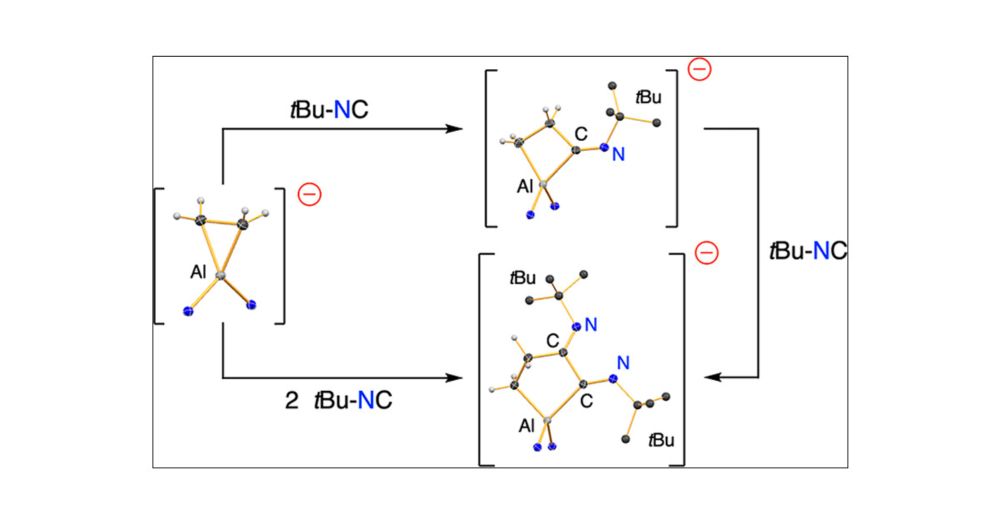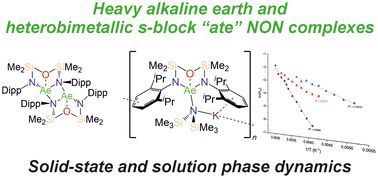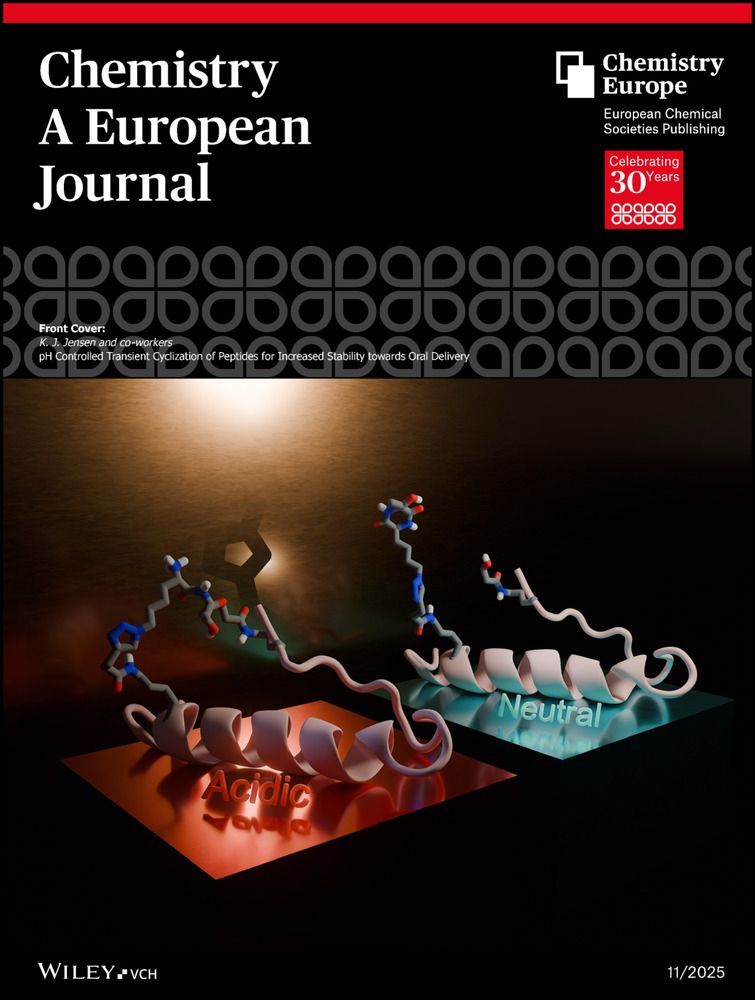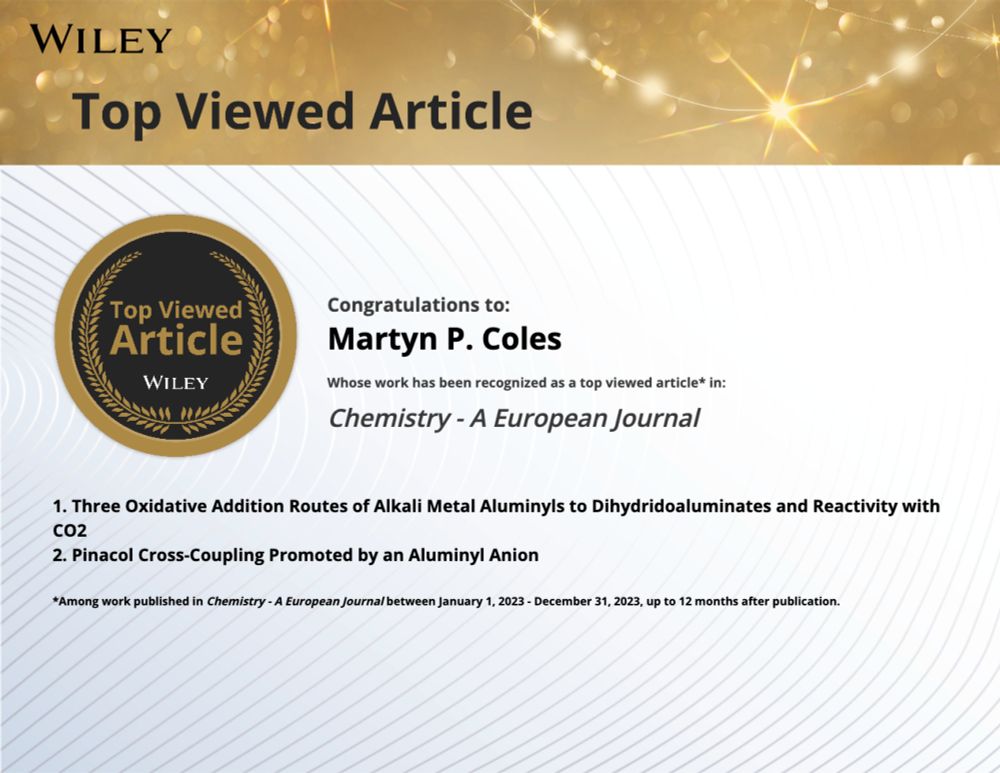Posts
Media
Videos
Starter Packs
Martyn Coles
@coles-lab.bsky.social
· Aug 12
Robin Fulton
@fultonro.bsky.social
· Aug 12

Reductive Deamination of a Diaminogermylene Promoted by an Aluminyl Anion: Isolation of Ge(I), Ge(0) and Ge(‐I) Products
The potassium aluminyl K[Al(NON)] reacts with Ge[N(SiMe3)2]2 by a sequential reductive deamination pathway. The initially formed aluminacyclodigermene contains Ge(I) centres and may be considered as ...
onlinelibrary.wiley.com
Martyn Coles
@coles-lab.bsky.social
· Jul 21

C–C Bond Formation at an Aluminacyclopropane
The reactivity of the aluminacyclopropane compound K[Al(NON)(η2-C2H4)] (NON = κN,N’-[O(SiMe2NDipp)2]2–; Dipp = 2,6-iPr2C6H3) toward isocyanides R–NC (R = Cy, Ad, tBu; Cy = cyclohexyl, Ad = 1-adamantyl...
pubs.acs.org
Reposted by Martyn Coles
Dalton Transactions
@daltontrans.rsc.org
· Mar 13

Heavier alkaline earth and heterobimetallic s-block “ate” complexes of a di(amido)siloxane ligand: solid-state structure and dynamic solution-phase behaviour
The diverse solid-state structures and solution-phase dynamics of both neutral and heterometallic s-block “ate” complexes of the heavier alkaline earth metals (Ae; Ca–Ba) supported by a chelating and…
pubs.rsc.org
Reposted by Martyn Coles
Reposted by Martyn Coles
Reposted by Martyn Coles
Robin Fulton
@fultonro.bsky.social
· Feb 21

Reaction of a Potassium Aluminyl with Sn[N(SiMe3)2]2 ‐ Isolation of a Stable, Trimetallic Sn(I) Radical Anion
The reaction of the potassium aluminyl K[Al(NON)] ([NON]2– = [O(SiMe2NDipp)2]2–, Dipp = 2,6-iPr2C6H3) with the stannylene Sn[N(SiMe3)2]2 in benzene afforded K3[(Sn4){Al(NON)}2{N(SiMe3)2}], containing...
chemistry-europe.onlinelibrary.wiley.com
Reposted by Martyn Coles
Robin Fulton
@fultonro.bsky.social
· Feb 13

Reductive Coupling of Ketones: Contrasting the Reactivity of an Aluminyl and a Gallyl Anion
The synthesis of a new potassium gallyl system, K[Ga(NON)] ([NON]2– = [O(SiMe2NDipp)2]2–, Dipp = 2,6-iPr2C6H3), has been reported, and its reactivity toward a variety of ketones has been studied. The potassium gallyl is initially isolated as the contacted dimeric pair (CDP) [K{Ga(NON)}]2 but can be converted to the monomeric ion pair (MIP) (NON)Ga–K(TMEDA)2 or the separated ion pair (SIP) [K(222-crypt)][Ga(NON)] upon addition of coordinating polydentate ligands. The reaction of the CDP with two equivalents of benzophenone or 9-fluorenone per gallium center generates homocoupled pinacolate products. However, the reaction with acetophenone initially forms a gallium 1,3-phenylethene-1-olate, which C–C couples to a second equivalent of acetophenone to form an unprecedented gallium 1,3-diphenylbutane-1,3-diolate. This reactivity is contrasted with the analogous potassium aluminyl CDP [K{Al(NON)}]2, where preferential formation of the pinacolate product is observed under the same reaction conditions.
pubs.acs.org


